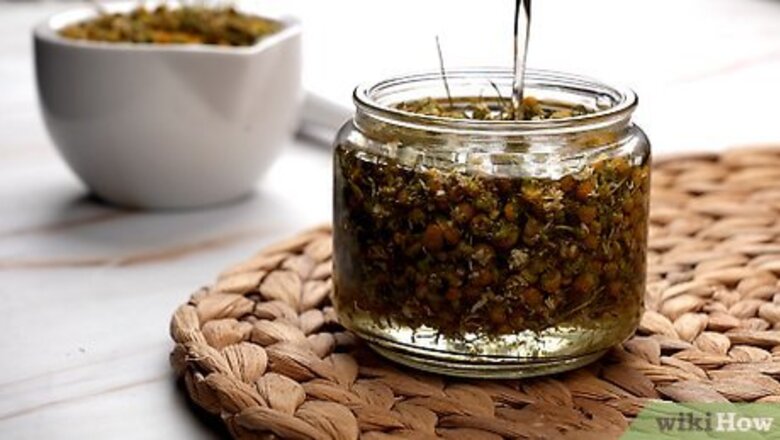
views
Making Herbal-infused Oil Powered by the Sun

Fill the jar. Fill a clean glass, lidded jar with your chosen herb. You should pack the herb relatively loosely in the jar. Fill the jar with your base oil. Make sure to cover all of the herbs with the oil. Leave half of an inch at the top of the jar. Cover the jar tightly. Pickling or preserving jars work very well for making your own herbal oil. Dried herbs work best because they do not contain water that can cause mold. If you don't use dried herbs, let them wilt for about 12 hours, then crush them with a mortar and pestle before putting in the oil. Choose an herb-based on how you intend to use the finished herbal oil. For example, you can use neem oil as a natural insecticide or dandruff treatment.
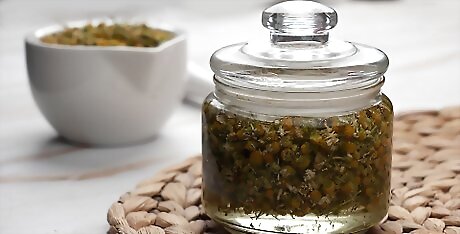
Allow the oil to set. Place the jar on a shelf where it gets plenty of sunlight during the day. Let the mixture sit for two weeks, mixing it by turning it upside down and then right side up twice a day. After two weeks, add one tablespoon of apple cider vinegar to the oil and mix. Let it sit on the sunny shelf for two more days. Mix it by inversion twice a day.

Filter the oil. After it has set for 16 days, the mixture is ready to pour out and use. Don't use the oil straight from the jar. You need to filter it first. Pour the oil through a cheesecloth into a new clean glass, lidded jar. This catches all of the herbs, leaving you with just herbs. Store the jar in a cool, dry, and dark place. If you want a stronger oil, add the new herb to the already-infused oil and repeat the process once more.
Infusing Oil Using the Oven
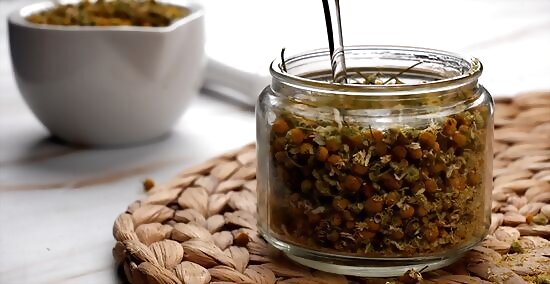
Place the oil and herbs in the jar. Fill a clean glass, lidded jar with your herb of choice. The herb should be packed loosely in the jar. Pickling or preserving jars work very well for this. Fill the jar with your chosen base oil, making sure to cover all the plant with the oil. Cover the jar tightly.

Put the jar in the oven. Cover the bottom of a baking pan with enough water to cover the bottom half of the jar. Then, place the jar with the herbs and oil into the pan and place in your oven. Turn the oven on with the lowest heat possible, usually 200o F, and let it cook for five to six hours. You can also preheat the oven to the lowest possible temperature, place the pan with the herb and oils in the oven and turn off the oven. If you do this, you will have to repeat the process by re-heating the oven over the five to six-hour period. The goal is to have a steady temperature as possible. Use an oven thermometer to help you keep track. Check every hour or so to be certain the oil is not bubbling or smoking. If it is, carefully removes the pan and let the oven cool down a bit. Once it cools, put the jar back into the oven.
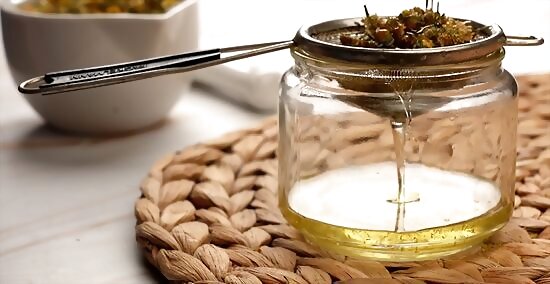
Remove the jar. After five or six hours, carefully remove the pan from the oven. Allow the jar to cool down by letting it sit. When it is cool, pour the oil through a cheesecloth into a new clean glass, lidded jar. This separates the herbs from the oil. Store the oil in a cool, dry, dark place.
Making Herbal Oil with a Crockpot
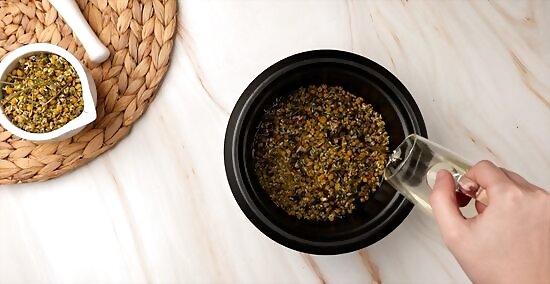
Place the ingredients in a crockpot. To infuse the herbs into the oil, place the herbs and enough oil to completely cover the herbs into the crockpot. Turn on the crockpot to the lowest setting. If you have a crockpot that has a keep warm setting, use that setting because it works the best. This method works well for making large batches of herbal oil. You can also place jars into the slow cooker. Just fill the crockpot halfway with water and cook them on warm.

Heat the oil. To infuse the herbs with the oil, you need to heat them in the crockpot. Allow the herbs to cook for two to four hours. Check frequently to make sure the oil is not bubbling or smoking. You can let the oil cook for up to 12 hours at 100 to 120 degrees Fahrenheit. Some crockpots are too hot to use to infuse oils. You will need to experiment.

Place the oil in a jar. After two to four hours, turn off the crockpot and allow the oil to cool down. When cool, pour the oil through a cheesecloth into a clean glass, lidded jar. This helps to strain the herbs from the oil. Store the oil in a cool, dry, dark place.
Understanding How to Make Oils
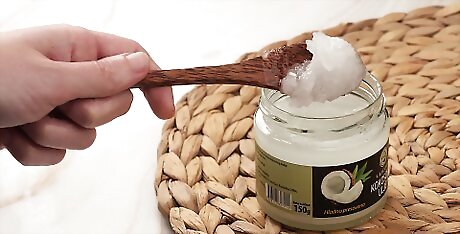
Decide on the base oil. Making an herbal-infused oil consists of three parts: oil, your chosen herb, and heat. You need to choose an oil to be the base. You will infuse the herb into the oil to make your herbal oil. Make sure to use a high-quality, and preferably organic, oil. You can use virgin olive oil, safflower oil, castor oil, argan oil, or coconut oil. These can be found at local health stores, grocery stores, or online.
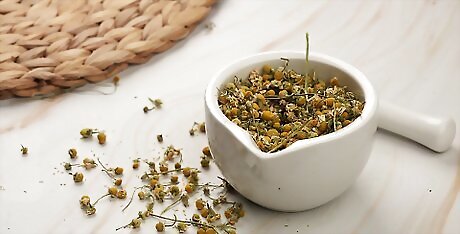
Choose your herb. When making your herbal oil, you have to decide which herb or herbs you want to use to make oil. Each batch will be a bit different because it depends on the season and the area from which the herbs have been gathered, the conditions around the time of harvest, and they type of herb you are using. You can use any of the herbs listed below, or any others that you grow or find. Lavender. This oil is used for relaxation aromatherapy. You can also use it to scent soaps. Lavender has antimicrobial properties as well. Calendula. This is used as an anti-inflammatory and to promote wound healing. Cannabis. If this is legal in your area, you use it for anxiety and pain relief. It can also be used as an antispasmodic and anti-nausea agent. Garlic. This is primarily used in oils as an antibacterial agent. Ginger root. Ginger is used as an anti-inflammatory agent. Goldenseal. This is used as an anti-inflammatory agent. Mullein. Mullein is used for respiratory and ear infections. Rosemary. It can be used in aromatherapy and in soaps. Rosemary is often used as a nootropic, which increases cognitive abilities and memory. Rosemary oil is also used as a muscle relaxant and antispasmodic. Thyme. Thyme is used for respiratory infections and to calm coughs. Oregano. This is used as an antimicrobial agent and immune booster. St John's wort. This is used as an antidepressant and to help get to and stay asleep. Chamomile. This is used as a relaxant and sleep inducer. Peppermint. Peppermint is used for digestive problems and irritable bowel syndrome. Eucalyptus. It is used for respiratory infections, sinusitis, and to calm coughs and relieve congestion.

Use the right ratio. Most oils are measured out using a parts method for the ratio. This means you can easily adjust the amount of oil and herbs needed for the quantity of oil you want to make. Five parts of oil to one part herb is a very common ratio. For example, you may put one tablespoon of dried herb for five tablespoons of base oil. The strength of the oil general is based on the length of time the oil infuses and the amount of heat used. However, each batch will probably be different due to factors of the herbs, including the growing and harvesting conditions or if it is fresh or dried.

Decide how you will use your oil. You can use herbal oils for so many different things. You can use them for natural medical treatments, cosmetics like hair care, face care, baby care, or body care, or even for cooking. Knowing how you will use the oil determines which base oil and herb you use. For example, if you are going to use the oil for cooking, you may choose a high-quality extra virgin olive oil. If you want to use the oil for cosmetics, jojoba, coconut, or argan oil may be a better choice. Different oils have different properties, so knowing why you need the oil helps you choose your herb.


















Comments
0 comment